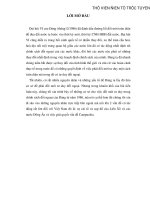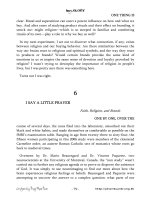I SAY A LITTLE PRAYER
Bạn đang xem bản rút gọn của tài liệu. Xem và tải ngay bản đầy đủ của tài liệu tại đây (133.28 KB, 15 trang )
buy.OLOGY
Designed by Trung Pham Tuan
- 79 -
ONE THING IS
clear. Ritual and superstition can exert a potent influence on how and what we
buy. And after years of studying product rituals and their effect on branding, it
struck me: might religion—which is so steeped in familiar and comforting
rituals of its own—play a role in why we buy as well?
In my next experiment, I set out to discover what connection, if any, exists
between religion and our buying behavior. Are there similarities between the
way our brains react to religious and spiritual symbols, and the way they react
to products or brands? Would certain brands provoke the same kind of
emotions in us or inspire the same sense of devotion and loyalty provoked by
religion? I wasn’t trying to downplay the importance of religion in people’s
lives, but I was pretty sure there was something here.
Turns out I was right.
6
I SAY A LITTLE PRAYER
Faith, Religion, and Brands
ONE BY ONE, OVER THE
course of several days, the nuns filed into the laboratory, smoothed out their
black and white habits, and made themselves as comfortable as possible on the
fMRI’s examination table. Ranging in age from twenty-three to sixty-four, the
fifteen women participating in this 2006 study were members of the cloistered
Carmelite order, an austere Roman Catholic sect of monastics whose roots go
back to medieval times.
Overseen by Dr. Mario Beauregard and Dr. Vincent Paquette, two
neuroscientists at the University of Montreal, Canada, the “nun study” wasn’t
carried out to further any religious agenda or to prove or disprove the existence
of God. It was simply to use neuroimaging to find out more about how the
brain experiences religious feelings or beliefs. Beauregard and Paquette were
attempting to uncover the answer to a complex question: what parts of our
buy.OLOGY
Designed by Trung Pham Tuan
- 80 -
brains light up when we’re engaging in private, spiritual experiences, such as
prayer, or when we’re experiencing the sensation that we’re close to God?
The scientists began by asking the fifteen nuns to relive the most profound
religious experience they’d had as members of the Carmelite order.
1
Unsurprisingly, the scans revealed that when reliving those experiences, the
nuns exhibited a flurry of neural activity in their caudate nucleus, a small,
central brain region that produces feelings of joy, serenity, self-awareness, and
even love. Another activated area was the insula, which the scientists theorized
relates to feelings associated with connections to the divine.
Then, the scientists asked the nuns to relive a profound emotional experience
they’d had with another human being. Interestingly, the activity recorded in
these scans was markedly different.
In short, Beauregard and Paquette concluded that while there is no single
“God Spot” in the human brain, no one discrete region that’s activated when
we’re engaged in religious or spiritual thoughts, there are—at least among those
with strong religious beliefs—different patterns of activity when thinking
about religion and when thinking about other human beings. As the next part
of our study would show, when it comes to religion and faith, a number of
integrated, interconnected brain regions work simultaneously and in tandem.
Or, as a quote I once stumbled across said, “Trying to draw strict borders
around consciousness is like trying to stick Post-it notes on the ocean.”
* * *
THIS STUDY WAS
part of my inspiration for my next brain-scan research experiment. But it
wasn’t as if my theory about brands and spirituality had come out of nowhere.
Consider the following story:
One early winter afternoon in 2007, a small, excited crowd gathered at the
storage bin at Port Newark in New Jersey, awaiting the arrival of a simple
container. Most of the onlookers were formally dressed in white gloves, long
black coats, and wide-brimmed hats. A rabbi stood in the center of the group,
while a few photographers snapped away. At last, the hatch of the ship’s hold
opened, and from the darkness a fastidiously dressed man emerged carrying a
silver tray containing packages of…dirt.
buy.OLOGY
Designed by Trung Pham Tuan
- 81 -
But this wasn’t ordinary dirt. This was holy dirt, brought to our shores
courtesy of Holy Land Earth, a Brooklyn-based company, the first business in
the world to export soil directly from Israel to the United States. But what do
people want with Israeli dirt, you might be wondering? Well, as it turns out, a
handful of soil from the Holy Land can add a perfect touch of the sacred to
religious burials. It can also be used to bless plants and trees, houses and
buildings.
Among the assembled throng was Holy Land Earth’s founder and president,
Steven Friedman, who addressed the dockside crowd. Many religions consider
the ground of Israel to be sacred, he explained; his company was now importing
this divine soil to anyone who wanted a small piece of the Holy Land in their
lives. In fact, the soil had the official stamp of approval from Rabbi Velvel
Brevda, the director of the Council of Geula in Jerusalem. “This is the
culmination of many years of hard work,” Friedman proclaimed. “It took quite
a bit of effort to not only satisfy import regulations, but to make sure our
product had the endorsement of recognized Jewish religious leaders.” But it was
all worth it, Friedman concluded.
Steven Friedman was hardly the first person to dabble in sacred dirt. In the
late 1990s, an Irish immigrant named Alan Jenkins spent nine years securing
U.S. government approval to import soil from Ireland. His reasoning? When
the Irish came to America, they brought with them their churches, schools, and
music—the only thing they had to leave behind was their soil. So, teaming up
with an agricultural scientist, he doggedly petitioned both the U.S. Customs
Department and the Animal and Plant Health Inspection Service to make Irish
soil legally exportable, and eventually won.
To date Alan Jenkins has shipped more than $3 million worth of Irish soil—
sold in 12-ounce plastic bags labeled Official Irish Dirt—to the United States.
For Irish immigrants, the soil of their native land has an almost religious
significance because, like many Jews, quite a few Irish immigrants pine to be
buried in the soil of their homeland. An eighty-seven-year-old lawyer in
Manhattan, originally from Galway, recently bought $100,000 worth of Irish
dirt to fill up his American grave. Another Irishman hailing from County Cork
spent $148,000 on a few tons to spread under the New England house he was
building. Funeral directors and florists have ordered the topsoil by the ton.
Even wholesalers in China have found dirt to be a lucrative business, as Chinese
customers have been seduced by the legend of Irish luck.
buy.OLOGY
Designed by Trung Pham Tuan
- 82 -
If companies can make money off holy dirt, why not holy water? According
to Newsweek, every bottle of “Holy Drinking Water, produced by a California-
based company called Wayne Enterprises, is blessed in the warehouse by an
Anglican or Roman Catholic priest. Like a crucifix or a rosary, a bottle of Holy
Drinking Water is a daily reminder to be kind to others,” says Brian Germann,
Wayne’s CEO. Not to be outdone, a Florida company has just rolled out a
product called Spiritual Water, which is basically purified municipal water,
adorned with nearly a dozen different Christian labels. The Virgin Mary bottle,
for example, has the Hail Mary prayer printed on the back in English and
Spanish. According to founder Elicko Taieb, Spiritual Water helps people to
“stay focused, believe in yourself and believe in God.”
2
If people are willing to pay sums large and small for things—like dirt and
water—that they believe have religious or spiritual significance, then clearly
spirituality and branding are inextricably linked. So I set out to prove it. But
before I could attempt to identify the link between the two, I had to find out
exactly what qualities characterize a religion in the first place. So in preparation
for what would turn out to be one of the most provocative pieces of research
I’ve conducted yet, I interviewed fourteen prominent leaders from various
religions around the world—including Catholicism, Protestantism, Buddhism,
and Islam—to find out what characteristics and qualities each of their faiths
shared. What I discovered was that despite their differences, almost every
leading religion has ten common pillars underlying its foundation: a sense of
belonging, a clear vision, power over enemies, sensory appeal, storytelling,
grandeur, evangelism, symbols, mystery, and rituals.
And just as I suspected, these pillars happen to have a great deal in common
with our most beloved brands and products. Let’s look at how.
Have you ever smiled knowingly at the person on the treadmill next to you
when you notice he or she is wearing the same brand of running sneakers? Or
honked and waved at the guy in the next lane because he’s driving a Toyota
Scion and so are you? My point is, whether you’re in love with Nike,
Neutrogena, Absolut, or Harley-Davidson, chances are you feel a sense of
belonging among other users of that brand—it’s like being a member of a not-
so-exclusive club.
This sense of belonging is a profound influence on our behavior. Think about
such seemingly unrelated groups as Weight Watchers at a meeting, the fans at
the Super Bowl, and the audience at a Rolling Stones concert. These events
buy.OLOGY
Designed by Trung Pham Tuan
- 83 -
bring together a group of people who share a similar mission, whether it’s to
conquer fat, win a trophy, or share in the collective joy of a musical
extravaganza. In fact, Whittier College professor Joseph Price, who studies
parallels between the worlds of sports and religion, has likened the Super Bowl
to a religious pilgrimage. “A religious pilgrimage is more than just a journey to a
place,” he says. “It involves interior exploration, quests for a transcendent goal,
overcoming barriers and physical or spiritual healing.”
3
Go Steelers.
Most religions also have a clear vision. By that I mean that they are
unambiguous in their mission, whether it’s to reach a certain state of grace or
achieve a spiritual goal. And of course, most companies have unambiguous
missions as well. Steve Jobs’s vision for Apple dates back to the mid-1980s
when he said, “Man is the creator of change in this world. As such he should be
above systems and structures, and not subordinate to them.” Twenty years and
a few million iPods later, the company still pursues this vision, and will
doubtlessly continue to do so twenty years from now. Or think about high-end
audio and video product maker Bang & Olufsen’s mission statement, “Courage
to constantly question the ordinary in search of surprising, long-lasting
experiences,” or IBM’s mandate, “Solutions for a Small Planet.” Like religions,
successful companies and successful brands have a clear, and very powerful,
sense of mission.
Successful religions also strive to exert power over their enemies. Religious
conflicts have existed since the beginning of time, and it doesn’t take more than
a glance at the news to see that taking sides against the Other is a potent
uniting force. Having an identifiable enemy gives us the chance not only to
articulate and showcase our faith, but also to unite ourselves with our fellow
believers.
This kind of us vs. them mentality can be seen throughout the consumer
world, as well. Coke vs. Pepsi, AT&T vs. Verizon, Visa vs. MasterCard. Think
about the recent Hertz campaign, and its tagline “We’re Hertz and they’re not.”
Or the TV spots in which the Apple user, played by the cool, good-looking
urban professional most guys aspire to be, and the PC user, the chubby,
bespectacled geek, debate the respective merits of their operating systems (with
the Apple user, of course, coming out on top). In fact, what commercial or ad
campaign doesn’t emphasize the reasons a given product is better than its
buy.OLOGY
Designed by Trung Pham Tuan
- 84 -
competitors? This us-vs.-them strategy attracts fans, incites controversy, creates
loyalty, and gets us thinking and arguing—and, of course, buying.
Sensory appeal (I’ll explore this further in Chapter 8) is another key
characteristic of the world’s great religions. Close your eyes and walk into a
church, a temple, or a mosque. You’re immediately enveloped in the ambience
of the building, as you smell the air, the incense, and the fragrance of the wood.
If you open your eyes, you’ll see the light reflect off the stained glass. Maybe a
bell is sounding, or an organ is playing, or a priest or rabbi or minister is
speaking. In a way, our senses allow us to “feel” the heart, soul, and sheer heft
of a religion. Isn’t the same true for products? Products and brands evoke
certain feelings and associations based on how they look, feel, or smell. Think
of the unmistakable sound of a Nokia ring tone. Or the pristine, leathery scent
of a brand new Mercedes-Benz. Or the sleek, aesthetically pleasing lines of an
iPod. Whether it’s annoyance or longing, products’ sensory qualities almost
always evoke an emotional response. That’s why, in 1996, Harley-Davidson
took Yamaha and Honda to court for infringing on the copyright of the
signature fast “potato-potato-potato” sound you hear when you rev up a Harley.
Or consider Toblerone. Chocolate in triangular shapes—now what’s that all
about? If Toblerone were rolling out its brand today, Wal-Mart probably
wouldn’t agree to carry it; the package isn’t stackable. But it’s the chocolate’s
appeal to our senses—its irregular shape, distinctively sweet taste, and hard,
subtly bumpy texture—that makes it uniquely Toblerone, and that, in fact, is
the secret of its success.
Another integral part of religion is storytelling. Whether the New Testament,
the Torah, or the Koran, every religion is built upon a heft of history and
stories—hundreds and hundreds of them (sometimes gruesome, sometimes
miraculous, and oftentimes both). And the rituals that most religions draw
upon and ask us to participate in—praying, kneeling, meditating, fasting,
singing hymns, or receiving the Sacrament—are rooted in these stories upon
which the faith is built.
In the same way, every successful brand has stories connected to it. Think of
Disney, and all the colorful characters that instantly come to mind, from
Mickey Mouse to Tinkerbell to Captain Jack Sparrow. Think of the small
canisters of salt and pepper that you picked up the last time you flew to London
on Virgin Atlantic, the ones that say Nicked from Virgin Atlantic. Or consider
Whole Foods’ recent decision to sell a limited number of bags inscribed with









